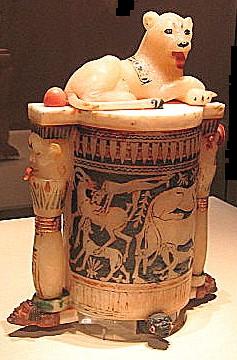
Alabaster is a mineral and a soft rock used for carvings and as a source of plaster powder. Archaeologists, geologists, and the stone industry have different definitions for the word alabaster. In archaeology, the term alabaster includes objects and artefacts made from two different minerals: (i) the fine-grained, massive type of gypsum, and (ii) the fine-grained, banded type of calcite.

Tartessos is, as defined by archaeological discoveries, a historical civilization settled in the southern Iberian Peninsula characterized by its mixture of local Paleohispanic and Phoenician traits. It had a writing system, identified as Tartessian, that includes some 97 inscriptions in a Tartessian language.

Ancient art refers to the many types of art produced by the advanced cultures of ancient societies with different forms of writing, such as those of ancient China, India, Mesopotamia, Persia, Palestine, Egypt, Greece, and Rome. The art of pre-literate societies is normally referred to as prehistoric art and is not covered here. Although some pre-Columbian cultures developed writing during the centuries before the arrival of Europeans, on grounds of dating these are covered at pre-Columbian art and articles such as Maya art, Aztec art, and Olmec art.

The Iberians were an ancient people settled in the eastern and southern coasts of the Iberian Peninsula, at least from the 6th century BCE. They are described in Greek and Roman sources. Roman sources also use the term Hispani to refer to the Iberians.

The Lady of Elche is a limestone bust that was discovered in 1897, at La Alcudia, an archaeological site on a private estate two kilometers south of Elche, Spain. It is now exhibited in the National Archaeological Museum of Spain in Madrid.

Astarte is the Hellenized form of the Ancient Near Eastern goddess ʿAṯtart. ʿAṯtart was the Northwest Semitic equivalent of the East Semitic goddess Ishtar.
Baalat Gebal, also known as Bēltu ša Gubla and Baaltis, was the tutelary goddess of the city of Byblos. While in the past it was often assumed her name is only an epithet, presently researchers assume that it is a proper name, meant to highlight her close connection to the corresponding city. She was identified with Hathor and later possibly with Isis by ancient Egyptians, and with Aphrodite by ancient Greeks. Philo of Byblos instead refers to her as "Dione", though the reasons behind this choice remain unknown. She was the main goddess in the local pantheon of Byblos, and a temple dedicated to her, which remained in use from the third millennium BCE to the Roman period, was located in the center of this city. She was venerated by the kings of Byblos, with a large number of references to her found in letters sent by Rib-Addi as a part of the Amarna correspondence. There is also evidence that she was worshiped by Egyptians, both in Byblos and in Egypt. She is mentioned in a number of literary texts, including the so-called Letter of Hori, the writings of Philo of Byblos, and Lucian's De Dea Syria.

The National Archaeological Museum in Athens houses some of the most important artifacts from a variety of archaeological locations around Greece from prehistory to late antiquity. It is considered one of the greatest museums in the world and contains the richest collection of Greek Antiquity artifacts worldwide. It is situated in the Exarcheia area in central Athens between Epirus Street, Bouboulinas Street and Tositsas Street while its entrance is on the Patission Street adjacent to the historical building of the Athens Polytechnic university.

The Punic religion, Carthaginian religion, or Western Phoenician religion in the western Mediterranean was a direct continuation of the Phoenician variety of the polytheistic ancient Canaanite religion. However, significant local differences developed over the centuries following the foundation of Carthage and other Punic communities elsewhere in North Africa, southern Spain, Sardinia, western Sicily, and Malta from the ninth century BC onward. After the conquest of these regions by the Roman Republic in the third and second centuries BC, Punic religious practices continued, surviving until the fourth century AD in some cases. As with most cultures of the ancient Mediterranean, Punic religion suffused their society and there was no stark distinction between religious and secular spheres. Sources on Punic religion are poor. There are no surviving literary sources and Punic religion is primarily reconstructed from inscriptions and archaeological evidence. An important sacred space in Punic religion appears to have been the large open air sanctuaries known as tophets in modern scholarship, in which urns containing the cremated bones of infants and animals were buried. There is a long-running scholarly debate about whether child sacrifice occurred at these locations, as suggested by Greco-Roman and biblical sources.

Two Minoan snake goddess figurines were excavated in 1903 in the Minoan palace at Knossos in the Greek island of Crete. The decades-long excavation programme led by the English archaeologist Arthur Evans greatly expanded knowledge and awareness of the Bronze Age Minoan civilization, but Evans has subsequently been criticised for overstatements and excessively speculative ideas, both in terms of his "restoration" of specific objects, including the most famous of these figures, and the ideas about the Minoans he drew from the archaeology. The figures are now on display at the Heraklion Archaeological Museum (AMH).

The National Archaeological Museum is a archaeology museum in Madrid, Spain. It is located on Calle de Serrano beside the Plaza de Colón, sharing its building with the National Library of Spain. It is one of the National Museums of Spain and it is attached to the Ministry of Culture.

The Department of the Middle East, numbering some 330,000 works, forms a significant part of the collections of the British Museum, and the world's largest collection of Mesopotamian antiquities outside Iraq. The collections represent the civilisations of the ancient Near East and its adjacent areas.

Carthaginian Iberia was a province of the larger Carthaginian Empire. The Carthaginians conquered the Mediterranean part of Iberia and remained there until the 2nd Punic war and the Roman conquest of the peninsula.

Lady of Cerro de los Santos, also known as Gran Dama Oferente, is an Iberian sculpture from the 2nd century BCE, that is now in National Archaeological Museum in Madrid.

Iberian sculpture, a subset of Iberian art, describes the various sculptural styles developed by the Iberians from the Bronze Age up to the Roman conquest. For this reason it is sometimes described as Pre-Roman Iberian sculpture.

The Temple of Eshmun is an ancient place of worship dedicated to Eshmun, the Phoenician god of healing. It is located near the Awali river, 2 kilometres (1.2 mi) northeast of Sidon in southwestern Lebanon. The site was occupied from the 7th century BC to the 8th century AD, suggesting an integrated relationship with the nearby city of Sidon. Although originally constructed by Sidonian king Eshmunazar II in the Achaemenid era to celebrate the city's recovered wealth and stature, the temple complex was greatly expanded by Bodashtart, Yatonmilk and later monarchs. Because the continued expansion spanned many centuries of alternating independence and foreign hegemony, the sanctuary features a wealth of different architectural and decorative styles and influences.

Galera is a municipality in the comarca of Huéscar, province of Granada, autonomous community of Andalusia, Spain. It is situated in a sparsely populated area roughly 150 kilometres (93 mi) from the provincial capital, Granada.

Kition was an Ancient Greek city-kingdom on the southern coast of Cyprus, one of the Ten city-kingdoms of Cyprus.

The Treasure of El Carambolo was found in El Carambolo hill in the municipality of Camas, 3 kilometers west of Seville, on 30 September 1958. The discovery of the treasure hoard spurred interest in the Tartessos culture, which prospered from the 9th to the 6th centuries BCE, but recent scholars have debated whether the treasure was a product of local culture or of the Phoenicians. The treasure was found by Spanish construction workers during renovations being made at a pigeon shooting society.

Amoashtart was a Phoenician queen of Sidon during the Persian period. She was the daughter of Eshmunazar I, and the wife of her brother, Tabnit. When Tabnit died, Amoashtart became co-regent to her then-infant son, Eshmunazar II, but after the boy died "in his fourteenth year", she was succeeded by her nephew Bodashtart, possibly in a palace coup. Modern historians have characterized her as an "energetic, responsible [woman], and endowed with immense political acumen, [who] exercised royal functions for many years".




















